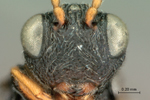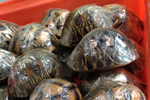After a final sighting in 1991, the Madagascar pochard was thought to have vanished for good. But this diving duck was rediscovered in 2006 when a flock of 22 individuals was found on Lake Matsaborimena in northern Madagascar by conservationists during an expedition. Soon after Madagascar pochard eggs were taken and incubated in a joint captive breeding program by Durrell, the Wildfowl & Wetlands Trust (WWT), the Peregrine Fund, Asity Madagascar, and Madagascar government, which recently announced that the population—both captive and wild—has nearly quadrupled.
“Although Lake Matsaborimena is the last hiding place for the ducks, it is far from ideal as a habitat,” Peter Cranswick, the head of Species Recovery at WWT, says explaining why the eggs were moved into captive breeding centers. “Our initial investigations suggest there is too little food and this may be leading to the low survival of the ducklings; in effect, they are starving to death.”
In addition to these factors, captive breeding programs will likely prevent devastating outbreaks of disease and the harmful effects pollution can have on the population, making the decision to take the animals into more secure conditions one that was critically important to their survival. Still, a small population persists in the wild.
Although considered relatively common in Madagascar’s Lake Alaotra through the 1930s, the Madagascar pochard was never observed to be a very widely ranged species. In fact, these ducks were only ever historically known to come from this single lake, but are thought to have once lived in shallow freshwater lakes and open marshes nearby dense vegetation throughout the central plain of Madagascar. Scientists presume that human colonization, leading to vast wetland loss, was the cause of the initial decrease in the birds’ range and numbers. The ultimate decline, however, has been attributed to the conversion of surrounding land to agriculture, deforestation leading to pollution and siltation, and the burning of aquatic vegetation. The introduction of non-native species to the area, as well as increased use of fishing nets in these wetlands, is also thought to have contributed to the duck’s downfall.
The Madagascar pochard itself is a medium-sized species of diving duck whose males have a distinctive white iris.. Thought to feed on benthic invertebrates, seeds, and aquatic plants, these ducks dive in shallow waters and can stay underwater for up to two minutes. They have been observed to be either sedentary or occurring in pairs. Their breeding season takes place between September and January and results in six to nine eggs being laid.
Since the commencement of the breeding program in 2009, the world’s population of the Madagascar pochard has increased nearly four-fold with the successful rearing of 38 ducklings. To date, the population stands at almost 80 individuals. With the second breeding season around the corner, the number of enclosures at the breeding center in rural Madagascar has increased, allowing the staff to pair up individual couples, providing them with the genetic information crucial to the long-term success of the program.
In future generations, provided success of the program continues, the captive-bred ducklings will be reintroduced to the wild into more secure habitats.
“The 58 Madagascar pochards in the captive breeding centre provide a safety net for the population if the tiny wild population were to go extinct,” Cranswick said recently. “We are now conducting detailed research in Madagascar to determine the species’ critical needs and to identify possible sites for future reintroductions.”

Madagascar Pochard, Captive Breeding Program, Madagascar. Photo by: Frank Vassen.
Related articles
Madagascar swamped by locust invasion
(04/17/2013) More than 60 percent of Madagascar is suffering from a massive locust infestation that is threatening crops and livestock, potentially increasing risks to native wildlife and forests from hungry farmers, warns the U.N. Food and Agriculture Organization (FAO).
Featured video: in-depth look at Madagascar’s Ranomafauna National Park
(04/03/2013) A new film Nosy Maitso takes a look at the people, researchers, and wildlife connected to Madagascar’s Ranomafauna National Park. Apart of a World Heritage Site, the park was established in 1991 after a new species of lemur, the golden bamboo lemur (Hapalemur aureus), was discovered in its forests in the 1980s. The golden bamboo lemur is currently listed as Endangered by the IUCN Red List.
Scientists discover new wasp species in a field box from the 1930s (photos)

(04/03/2013) Searching through materials at the Natural History Museum in Paris, Simon van Noort recently came across a long-neglected field box of wasp specimens. Collected 80 years earlier by André Seyrig in Madagascar, the box contained several specimens of wasp in the Paramblynotus genus. The big surprise: wasps in this genus had never before been seen in Madagascar.
Madagascar’s chameleons came from African mainland
(03/29/2013) Madagascar’s color-changing chameleons originated in Africa and crossed over to the island some 65 million years ago, concludes a study published this week in the Proceedings of the Royal Society B.
2 ‘giant’ yet tiny mouse lemurs identified in Madagascar
(03/27/2013) Scientists have discovered two new species of mouse lemurs in Madagascar, bringing the total number of diminutive primates known to science to 20.
Researchers sequence Aye-aye genome – lemur is more genetically diverse than humans
(03/26/2013) Scientists sequenced the genome of the aye-aye, a bizarre lemur species, for the first time. The research is published in the journal Proceedings of the National Academy of Sciences (PNAS).
Over ten percent of a species’ total population found in smuggler’s bag

(03/25/2013) On Friday, March 15th Thai authorities arrested a 38-year-old man attempting to collect a bag containing 54 ploughshare tortoises (Astrochelys yniphora) and 21 radiated tortoises (Astrochelys radiata) in Suvarnabhumi International Airport. Found only in Madagascar both species are listed as Critically Endangered and protected under the Convention on International Trade in Endangered Species (CITES), but have become lucrative targets for the black-market pet trade given their scarcity and beauty.
Deforestation in key Madagascar park accelerated after 2009 coup d’etat, finds satellite analysis
(03/18/2013) Deforestation and forest disturbance in Madagascar’s largest national park increased significantly less than a year after a coup displaced the country’s democratically-elected president in 2009, finds a new study that analyzed forest cover in Masoala National Park.
Frogs radio-tracked for first time in Madagascar
![]()
(03/01/2013) Researchers have radio-tracked frogs for the first time in Madagascar. Attaching tiny radio transmitters weighing 0.3-0.35 grams (1/100 of an ounce) to 36 rainbow frogs (Scaphiophryne gottlebei), the research team tracked the movement of the colorful frogs through rugged canyons in Madagascar’s Isalo Massif. They found that the frogs have a short breeding period that occurs after the first intense rainfall at the start of the rainy season.
Travel in Madagascar: strange wildlife and stunning landscapes

(02/27/2013) The promise of lemurs, lizards, and a bouquet of biodiversity brought mongabay.com founder Rhett Butler to Madagascar sixteen years ago. He was not disappointed by what he found and was inspired to return, many times to experience the wildlife, landscapes, and people of the dynamic island. In 2004, Rhett founded wildmadagascar.org, a site that highlights the spectacular cultural and biological richness of Madagascar and reports on environmental news for the Indian Ocean island nation.